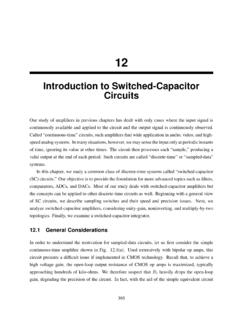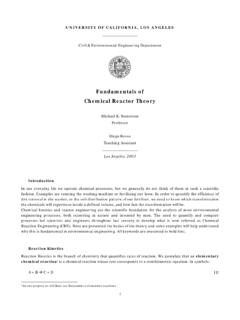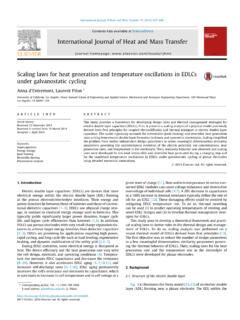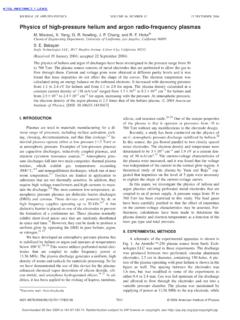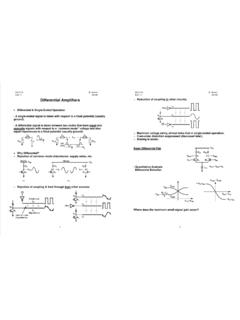Transcription of CMOS technology characterization for analog and …
1 268 IEEE JOURNAL OF SOLID-STATE CIRCUITS, VOL. 34, NO. 3, MARCH 1999 cmos technology Characterizationfor analog and RF DesignBehzad Razavi,Member, IEEEA bstract The design of analog and radio-frequency (RF)circuits in cmos technology becomes increasingly more difficultas device modeling faces new challenges in deep submicrometerprocesses and emerging circuit applications. The sophisticated setof characteristics used to represent today s digital technologiesoften proves inadequate for analog and RF design , mandatingmany additional measurements and iterations to arrive at anacceptable solution.
2 This paper describes a set of characterizationvehicles that can be employed to quantify the analog behaviorof active and passive devices in cmos processes, in particular,properties that are not modeled accurately by SPICE structures and circuits are introduced for measuring speed,noise, linearity, loss, matching, and dc Terms analog circuits, device noise, mismatch, MOSdevices, RF circuits, technology INTRODUCTIONAS cmos technology continues to benefit from bothscaling and the enormous momentum of the digitalmarket, many high-speed and radio-frequency (RF) integratedcircuits that were once considered the exclusive domain ofIII V or silicon bipolar technologies are likely to appear asCMOS implementations.
3 However, issues such as technologydevelopment costs, computer-aided design (CAD) infrastruc-ture, and fabrication turnaround time make it desirable to usea single mainstream digital cmos process for all IC products. analog processes may be approaching design of analog and RF circuits in a digital cmos technology faces many difficulties: the set of available activeand passive devices is quite limited, the technology is opti-mized for digital design , and the devices are characterized andmodeled according to simple benchmarks such as current driveand gate delay.
4 While the first two issues can be somewhatalleviated by circuit and architecture innovations, the quandaryof poor characterization leads to substantial conservatism inanalog design , thus resulting in circuits that do not exploitthe raw speed of the technology . In some cases, evenconservatism does not solve the problem, mandating lengthyiterations in the design . For example, in a narrow-band RFoscillator, it is difficult to guarantee a correct output frequencywithout accurate data on device parasitics and their variationwith process and paper describes a set of technology characterizationmethods that provide the basic information required in ana-Manuscript received August 11, 1998.
5 Revised October 26, author is with the Electrical Engineering Department, University ofCalifornia, Los Angeles, CA 90095 Item Identifier S 0018-9200(99) 1. analog design and RF design . It also reviews some relevant modelingdifficulties. Section II presents the motivation for and theissues related to the task. Sections III and IV deal withcharacterization for analog and RF design , respectively. Forthe sake of brevity, we use the term analog to mean analogand RF.
6 II. MOTIVATION ANDISSUESThe principal difficulty in using a digital cmos technol-ogy for analog design is that the process is optimized andcharacterized for primarily one tradeoff: that between speedand power dissipation. By contrast, analog circuits entail amultidimensional design space. This is illustrated in Fig. 1,where almost every two parameters trade with each other. Thetrue severity of these tradeoffs is known only if relevant datahave been obtained for the need for specialized analog characterization arisesfrom two types of shortcomings: inaccurate modeling ( , theoutput resistance of transistors or its nonlinearity) or simplylack of modeling ( , self-resonance frequency of inductorsor matching properties of transistors).
7 While efforts towardimproving submicrometer device models continue vigorously,scaling appears to degrade the modeling accuracy faster. Thatis, it seems that for no generation of cmos devices havemodels been sufficiently is also important to note the rapid migration of digitalcircuits from one generation of the technology to the circuits have historically lagged behind by more thanone generation, failing to utilize the full potential of newprocesses or to comply with their supply-voltage scaling.
8 Asolid understanding of the properties and limitations of devices1 This is the author s opinion rather than a documented 9200/99$ 1999 IEEERAZAVI: cmos technology CHARACTERIZATION269also minimizes the number of design iterations and hence thetime to above observations indicate that analog design in a newtechnology can be greatly simplified ifmeasureddata pointsdescribing the analog behavior of devices and subcircuits areobtained. In fact, such data points do become available asanalog designers begin to use a process, but in an ad hocmanner and very slowly.
9 A unified effort to collect all of thenecessary data soon after the qualification of a technology israrely characterization for analog design nonethelessinvolves a number of difficult issues. Owing to the lack of universally applicable analog bench-marks, many test structures must be built to satisfy theneeds of various systems. Op-amps, filters, comparators,data converters, oscillators, phase-locked loops, frequencysynthesizers, and RF transceivers incorporate many dif-ferent functions that heavily depend on poorly modeledproperties of devices.
10 Some device characteristics, for example, capacitor mis-match and thermal andnoise, are difficult to , proper circuits must be included on the die to allowreliable measurement. Some measured properties are difficult to incorporate insimulations. For example, the voltage dependence of theoutput impedance of transistors cannot be easily includedin the simulation of an op-amp. Such cases may mandatedesigning a complete circuit to measure the overall effect. The large number of test structures requires substantialcharacterization time and effort.


